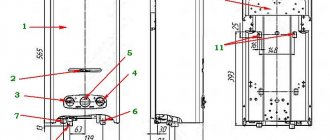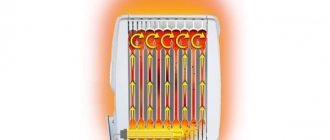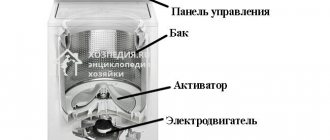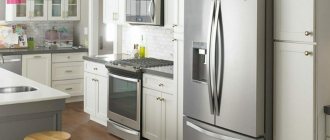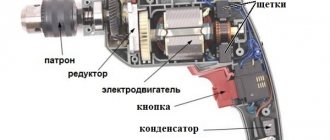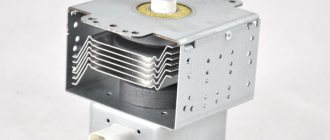Hello, dear readers of the KtoNaNovenkogo.ru blog. We cannot imagine life without all kinds of gadgets and devices.
Every day they become more and more advanced. As a result, many of us, seeing this or that device, cannot understand its purpose.
Let's talk about a plotter, which can be found in many offices today. What is it for, how does it work, and how is it different from a regular printer?
What is a plotter and what is it used for?
Before you begin to review the equipment, you need to understand its purpose. Basically, a plotter refers to a printing device. Essentially, it is an analogue of a printer, but more advanced. The plotter device allows you to perform large-format printing, create drawings, 3D postcards, advertising signs and other products. If the printer prints only on paper, then the media can be cardboard, fabric, film and other synthetic materials. There are special models, the device of which allows you to apply an image to T-shirts, other light clothing and even round objects, such as cups.
A plotter is similar to a printer, but has advanced functions.
Initially, the equipment was intended only for printing. Over time, his device was improved. Now this concept refers to machines that can not only print, but also cut out shapes from the media.
Pencil plotter
This device acquired its name from the element that directly applies the drawing - a pencil lead. Such a plotter does not require constant monitoring and control from the outside during operation.
The gradually depleting lead moves out of the clamp in a timely manner, and this is an undeniable advantage in the process of continuously applying several images in a row. In a pen plotter, related to this type of device, changing the drawing element is problematic and requires stopping printing to fix the problem and clean the channel through which ink is supplied to the pen.
A pencil lead allows you to clearly and accurately apply various types of drawings to paper, as well as remove or edit imperfections in drawing elements with an ordinary eraser.
History of the creation of the plotter
In various sources there is equipment called a plotter. These are the plotters that were originally named that way. The machines were intended for drawing diagrams, tables, maps and other graphic images on large format media.
Initially, plotters were designed for printing graphic images on large media formats
Plotters appeared with the beginning of the development of computerization. In 1959, the first Calcomp 565 model went on sale. The device moved paper along its axis with wheels. Drawing was carried out with a writing pen.
Calcomp 565 was replaced by an improved Computervision's Interact I plotter. The equipment was equipped with an auto-design system. The drawing element was replaced with a ballpoint pen. The advantage of the equipment was high image accuracy. Over time, the manufacturer modernized it. It became possible to apply colored designs using multi-colored feathers.
High-resolution tablet models appeared in 1970. The equipment was produced by manufacturers HP and Tektronix. The electronic devices were the size of a table.
A modern plotter is a multifunctional device
A modern plotter is a device used for bright, colorful, high-resolution printing. Many models have large RAM and hard drive. An additional cutting function has appeared. Drawing blocks have been improved, allowing the medium to use not only paper, but also other materials.
Features of choosing a plotter
Given the wide range of plotter models available on the modern consumer market, the potential user should be aware of the basic technical characteristics of the devices in question. The defining indicators rightfully include:
- Purpose of the purchased equipment. So, when planning to use a device for printing drawings and maps, you should give preference to devices with a minimum set of functions. The capabilities of the “budget” options are enough to perform high-quality “primary tasks”. However, if you plan to use a plotter for printing advertisements, banners, and so on, it is advisable to choose devices with the option of “materializing” color images.
- Maximum cutting width. This indicator is inextricably linked with the format of the material that is compatible with the selected gadget model. If you plan to use the plotter at home, you should choose a device with a maximum cutting width of 250 mm, and when purchasing the equipment in question for subsequent use in production, the optimal size of the material available for cutting is no less than 1000 mm.
- Print speed. An acceptable indicator of the characteristics under consideration is considered to be a speed of at least 8 - 10 sheets per second. In this case, the plotter will be as productive as possible with moderate power consumption.
- Financial costs for operating the gadget. In this case, we are talking not only about the need to select the type of devices in question with high-quality assembly with high strength of individual functional elements, but also plotters that do not require a special media format. In other words, in accordance with this criterion, the selected model must be compatible with all (or the absolute majority) of materials.
- Feed type. When further using the selected equipment at home, it is advisable to pay attention to roll plotters, which are distinguished by their compact design and low cost of consumables. In case of planned use of the purchased plotter in production, flatbed models will be ideal; they have high accuracy in operation, but, as a rule, have impressive dimensions.
- Maximum knife pressure (when choosing a cutting plotter). The optimal indicator of the characteristic under consideration, as a rule, is a “force” of at least 200 g. Devices that meet this requirement will provide their owner with high-quality performance of their functional “responsibilities” associated with cutting material with minimal energy consumption on the part of the user.
- Manufacturer's warranty. Considering the high cost of the vast majority of equipment models in the segment under consideration, it is reasonable to pay attention to the warranty period provided by the manufacturer or supplier. On average, the “creators” of a plotter “vouch” for their product during the first 2 years of its use.
To form an idea for the buyer about what parameters a high-quality plotter should have, it is advisable to familiarize yourself with the rating below of the top models of 2021.
What is the working principle of a plotter
The work of the first plotters was to move the paper medium along the X coordinate. The movement of the drawing pen occurred along the Y coordinate. Equipment with a ballpoint pen was controlled by a computer. Modern plotters operate via a connection to a computer port, SCSI interface and Ethernet. Advanced devices have their own built-in buffer and control display. For control, there are special programs where the operator develops an image and sets parameters. When the project is ready, it is sent for printing. The device receives the signal and begins to perform the task exactly according to the program.
The best textile plotters
If you don't know which plotter to choose for creating images on fabric, we offer the following models to choose from.
5.
Mimaki TS300P-1800 : 1,681,978 rubles
Top record holder in terms of acceptable print format. At the same time, the unit weighs 213 kg, and the maximum width of the printed material is 1940 mm (larger than A0 format). It is quite clear why there is no sheet feed, but only roll feed. The maximum roll diameter is 250 mm, weight is 40 kg, thickness is up to 1 mm. Prints not only on fabric, but also on polyester, transfer paper, sublimation printing, and heat presses.
Piezoelectric technology works well with sublimation inks. The resolution you can count on is 1040×1040 dpi. Moreover, the color scheme comes in two types: 4 and 6 colors. The basic configuration includes a CISS, where a two-liter tank is allocated for each color.
The equipment is equipped with a variety of innovations to ensure high-quality printing and minimal defect rates. For example, a vacuum tension system, auto-winding, print control and voltage waves on the print head.
6.
Roland Texart XT-640 : 2,233,594 rubles
Guarantees high-quality printing on textiles and paper using specially created Texart SBL3 ink, therefore it is included in our rating of plotters. The paint dries quickly, does not smudge, and adheres firmly to almost any surface. Automatic rewinding with a tension system ensures a stable supply of material without distortions.
Productivity is 63 m2/h, maximum resolution 1440×1400 dpi. The print head is controlled electronically, so it can produce droplets of seven different sizes. As a result, we get high-quality, contrasting graphics. Supports RIP ErgoSoft Roland Edition 2, making it easier to edit templates and customize printing.
Operates via a mobile application, quickly and easily connects/sets up.
Main types of plotters and their characteristics
There are three types of equipment that differ in functionality: cutting, printing and combined plotters. The third option is of great interest. Such devices are often called hybrids. You may come across the name plotter-cutter. The advantage is that you can cut and print images on a plotter. There is no need to purchase two expensive devices.
Important! A hybrid plotter is indispensable in the production of stickers and other similar products where it is necessary to apply an image and cut it along a certain contour.
If we talk about the main varieties, then there are two groups of plotters: cutting and printing. Each device performs only one specific function.
Cutting plotters
From the name of the device one can already judge that it is intended only for cutting media. The plotter is equipped with a knife that, according to a trajectory specified by the program, cuts out a fragment, a complex pattern, and even text.
The cutting apparatus is equipped with a knife instead of a printing unit
Essentially, a cutting plotter is a cutting machine. Select a device according to its characteristics. First of all, the format is taken into account, which determines what size media can be used. Cutting speed affects productivity. The pressure of the knife and the type of cutter determines what material the carrier can be used from, for example, film, cardboard.
Attention! An important feature for a cutting plotter is the presence of an optical sensor. The positioning device ensures cutting accuracy. The knife does not extend beyond the marked boundaries of the cutting lines.
Printing plotters
Printing equipment can only apply an image to a medium. The design of the devices is different. Instead of a knife, the working unit is a drawing block. The method of applying the image depends on the printing technology.
Printing devices are only capable of printing an image onto a medium
To use the plotter for its intended purpose, you need to choose the right device taking into account its characteristics. Printing speed, as in the previous device, affects performance. Resolution is responsible for the clarity of the image at certain sizes. The format determines what size media can be used and what size the image will be. The color rendering parameter affects the brightness and saturation of the picture. Such plotters are needed in the production of advertising products. For drawing graphic images, color rendering quality is not particularly important.
Advice! A high-speed printing machine is needed to produce large quantities of products.
Possibilities
In addition to large-sized advertising posters, this device is indispensable for creating topographic maps, drawings, and projects. Design companies use it in production :
- 3D postcards;
- stickers and stickers;
- invitations to holidays;
- designer jewelry.
The cutting plotter's capabilities allow you to cut shapes from various materials:
- self-adhesive and magnetic vinyl;
- thermal films;
- photo paper;
- skin;
- textiles;
- plastic.
This device can also create an embossed texture on soft material, engraving on metal (you need to purchase a special attachment for this).
It’s worth noting right away that a plotter is primarily a printing device; the cutting function is considered additional. But today there are devices designed exclusively for cutting.
A cutting plotter is sometimes also called a cutter (from the English “cut” - to cut).
A conventional cutting machine is capable of cutting paper up to 2 mm thick. But modern professional models can work with media (consumables) up to 120 mm thick.
Types of plotters according to the method of sheet placement
The carrier for the equipment is paper, cardboard, film, synthetic fabric and other materials. They come in the form of sheets or rolls. Each type of plotter is designed to feed a specific media, which determines its design.
Flatbed plotters
The design of tablet-type equipment is similar in functionality to a printer. The technique only works with sheet media. It is fixedly fixed on the table using magnetic, electrical or mechanical fixation.
The design of flatbed models includes a large table for sheets of media
Tablet devices are usually used to print images in A2 and A3 formats. The disadvantage is the large size due to the presence of the table. Because of this, tablet-type devices are not very popular. This technique is in demand when printing advertising signs of huge sizes.
Roll plotter
A special feature of roll equipment is its compactness. The media is wound into a roll of a certain thickness. The feed occurs along the drum, where, during the movement, the drawing block applies the image.
The design of roll models allows the use of long media wound on a roll with compact equipment sizes
The device requires little space. Roll models save consumables and have better print quality. The devices also win in terms of functionality. Their device allows you to perform a greater number of tasks.
The best inkjet plotters
Let's start with the budget category. The availability of technology is explained by the fact that printing is carried out using simple inkjet technology using standard water-soluble or pigment inks.
1.
HP DesignJet Z9+ 24" Postscript : 330,100 rubles
Multifunctional “American” for professional printing. Weighs 72 kg, is installed on the floor, and comes with nine cartridges with pigment ink and one with additional composition. The picture resolution is impressive - 2400×1200 dpi, and the accuracy of drawing lines is up to 0.1%.
Allows you to work with formats up to 610×1676 mm. Materials are fed from above and from behind, and rolls can also be used. This is where an automatic paper cutter is key. The catch basket is used to neatly place prints. The plotter is capable of working with materials with a thickness of 500 g/m2.
The electronic hardware is also impressive. 4 GB RAM, 500 GB hard drive - parameters worthy of a computer. Therefore, nothing slows down even when processing large amounts of graphic information.
The equipment supports the cloud printing option and is accompanied by proprietary drivers for Windows, Mac OS, iOS, and Android. At the same time, the noise is within normal limits - 45 dB, and consumes about 100 W. The print speed is 73.9 m²/h.
2.
Canon imagePROGRAF iPF685 : 163,441 rubles
The rating of plotters would be incomplete without this model, which will provide everything necessary for efficient printing.
The picture is formed using a four-color model. There is also one additional color - matte black. Color inks are water-soluble, while black inks are pigment inks. In this case, the resolution is high - 2400 × 1200 dpi. There is an option for photo printing, as well as borderless output. Consumes 140 W, weighs 52 kg, so it is perfect for office work.
The interesting thing is that you can choose the cartridge volume yourself: 130 or 300 mm. Hot-swappable cartridge available. As for the dimensions of the materials, the sheet width is up to 914 mm, the roll is up to 610 mm, and the thickness is up to 0.8 mm.
The electronics will be more modest: 256 MB of RAM, 320 GB of hard drive space. The equipment supports cloud printing and also boasts clear and simple software.
What types of plotters are there by type of drawing block?
A special feature of printing machines is the presence of a drawing block. The printing technology depends on its device. Each drawing block is capable of working with a specific type of media.
Pen plotters
The writing head of the equipment has a device in the form of pens. This is where the name came from. During operation, the pen moves in two directions. The devices are considered to be of the vector type and come in two types: some draw with liquid paints, others apply the image with slate pens.
Pen models are vector-type devices
The head is driven by a motor, which creates a certain level of noise. The advantage of a pen device is high print quality, contrast and good color rendering. Disadvantage: low printing speed.
Inkjet plotters
In terms of printing technology, the devices resemble ordinary household inkjet printers. The picture is applied with liquid paints sprayed from the nozzle of the writing head. Most models work with 4 base colors. Other shades are obtained by mixing paints.
Most inkjet plotters work with 4 basic ink colors
The jet head is equipped with a large number of nozzles. During printing, they heat up, due to which an air-filled bubble is formed, which, under pressure, squeezes the ink onto the media. The advantage is simple operation of the plotter, high productivity, clear pictures, and affordable prices for consumables.
Electrostatic plotters
This category includes devices that apply an invisible image with charged particles onto a special medium. Liquid ink sticks to them and is finally fixed by drying.
Equipment with electrostatic printing technology is sensitive to room temperature and humidity
The advantage of plotters is the high speed of drawing. However, electrostatic devices can operate properly if the room is maintained at the manufacturer's recommended humidity level and air temperature.
Important! Electrostatic models are expensive and difficult to maintain.
Laser and LED plotters
The design of equipment in this category resembles laser printers. First, the head applies an invisible image to the media using a beam. Dry powdered paint - toner - sticks to the charged particles. Once heated and passed through the media drum, the ink is baked into a permanent image.
The writing head of the laser device has a long service life, since the possibility of paint drying on it is eliminated
The advantage of laser and LED devices is high performance. Due to the high resolution, clear images are obtained. The downside is the high cost of the equipment.
Direct image plotters
Printing technology is based on the use of thermal paper. The media passes through a special head - a comb. It is equipped with many heaters. Depending on the heating temperature, a certain color of each point of the pattern appears on the media.
Models with direct image output technology print on thermal paper
The peculiarity is that the mechanism of operation of plotters for direct image output during monochrome printing allows you to obtain a high-quality image with good clarity. The equipment is more in demand by engineering organizations for drawing up projects.
Thermal feed plotters
The printing technology and writing head design are similar to those of models with direct image output. The carrier is thermal paper, but between it and the comb there is a special film called a color donor.
Thermal feed machines print beautiful color images
During printing, the head passes over the media the required number of times. Warming up at a certain temperature, the donor leaves the desired color on thermal paper. Printed products do not fade from UV rays and are resistant to moisture.
The nuances of cutting on a plotter
The quality of cutting depends on a number of criteria.
- Blade sharpness. The newer the knife, the sharper it will be. Of course, for simple tasks, for example, cutting paper, not the newest knife is suitable, but for jewelry work, where much depends on accuracy, the blade should be as sharp as possible.
- The quality of the source, i.e. how complex and correct the drawing itself is. Sometimes it takes more time to finalize a file than to print and design. After all, if even one indicator does not converge somewhere, the structure of the picture will be disrupted.
- The mat should be sticky enough to hold the consumable material (fabric, vinyl, etc.) well.
- Customization for a specific material. Typically, all available settings can be viewed in the properties of the device itself. It is best to set them manually, because the equipment will not be able to recognize the material on its own.
In order to try out a new material in practice, you must always have some kind of drawing on hand. Test samples offered by the manufacturer do not always reflect the real picture, because... involve cutting circles and squares, in which there is nothing complicated.
It is highly not recommended to carry out a full template without preliminary testing - there is a high probability of incorrectly set material.
Another important factor in case it involves cutting several materials at once. You need to have a separate knife for each material: blades for paper and fabric are quite different . Some experts mark the blades so as not to confuse them. For example, “T” is fabric, “K” is cardboard, etc.
If you plan not only to print patterns, then you will need to work with the pressure and offset of the knife, setting the necessary in the system settings. The difference in working with fabric is only in the principle of further use: cutting for sewing or making appliqué. For cutting on cardboard, the height to which the blade will rise is important. Since the material itself “plays” easily, it is necessary to ensure that when cutting the cardboard is well fixed in one position to prevent distortion.
Film
Oracal film requires special precision when preparing for cutting. Since the vinyl base can easily be subject to deformation, pinpoint precision is required at the time of fixation. The larger the image (drawing, logo, etc.), the more careful the layout designer should be. When working with this material, it should be borne in mind that cutting will only be an intermediate process. Vinyl film goes through several processing stages before acquiring its finished look. If you compare it with other materials, for example, fabric, you can note a certain complexity during operation.
How to use a plotter
To work, you will need special software. It comes with the device. If the basic program is not satisfactory, you can use third-party software. To print on a plotter, you need to do the following:
- create a pre-prepared file in the program or find it on the computer;
- click the “Print” command in the menu;
- in the equipment line, find the plotter connected to the computer, click the “Properties” command;
- set the parameters in the menu that appears, click the “Ok” command;
- First, a preview of the picture will appear, and if everything is satisfactory, give the “Print” command.
The nuances of operation may vary depending on the installed operating system and the programs used.
You can use a plotter for cutting in a similar way, but there are a lot of nuances. First, the device is tested on unnecessary media, so as not to spoil the material, for example, with color pictures for cutting.
The cutting device must be tested before use.
After submitting the “Properties” command, in the settings you set the pressure on the knife and the length of its extension, which depends on the media used. Next comes the image preview and the “Print” command.
All cutting type plotters cannot automatically adjust to the media type. The operator must do everything himself. It is important to check the sharpness of the knife, the accuracy of the constructed image, and place a substrate with good adhesive properties under the media so that the material does not move during cutting.
The video contains interesting information about the plotter:
Programs for equipment operation
Before starting operation, the device should be connected to a laptop or personal computer (PC) with the appropriate software installed on it. The computer sends the image that needs to be cut or printed to the cutter (plotter), after which the knife or drawing block comes into action.
Important! Working on a plotter is only possible if it has software similar to that of a computer.
The easiest way to cut on a plotter is from CorelDraw (“from Corel”). This program is designed to work with graphic documents and design images. CorelDraw is perhaps the most famous vector editor. However, besides this, there are a number of programs that are suitable for working with a plotter.
- PlotCalc. It has a simple interface and does not require much training time.
- SignCut. Paid software with preview function that has free plugins for popular design packages.
- OMEGA CUT. Suitable for working with design documentation, functions include scanning images and converting them into vector form, creating fonts and processing curves.
Advice! For 2-in-1 units (printing and cutting), it is better to use your own software that comes with the devices. Developed by the manufacturer, it will make it possible to expand the functionality of the plotter, for example, to control the cutting depth of the knife, and will minimize the likelihood of errors and inconsistencies.
Setting up and installing the plotter
Before you start, you need to configure the plotter, and if it is being used for the first time, installation is required. The manufacturer supplies its device with an installation disk. It usually contains instructions, drivers, and software. To install, you need to load the disc into the drive and follow the pop-up prompts. If for some reason the disk is not available, everything can be downloaded online from the manufacturer’s website. After installing the software, click the “Devices” button in the Start menu. The operating system must detect the device. In the “Printers and Faxes” line, double-click with the left button of the computer mouse. In the window that appears, set the required settings.
One of the popular programs for work is Corel Draw.
The settings you have made can be saved and used in the future. They are changed if necessary. After settings, the equipment is put into operation provided there is a ready file for printing or cutting. If it doesn’t exist, create it in Corel Draw, Plot Calc, Sign Cut or another similar program.
Best UV plotters
How to choose a plotter that can print on any substrate? Pay attention to UV models and their technical characteristics. They transfer the image to any substrate without pre-processing.
7.
Mimaki JFX200-2531 : 8,590,746 rubles
The best plotter for large-format printing: it works with A0 materials, has many options and weighs about a ton. The working field reaches a width of 2500 mm. Printing speed - 25 m2/h, resolution - 1200×1200 dpi.
The plotter prints only on sheet materials. But it can be almost any material: acrylic, polycarbonate, PVC, glass, aluminum, polyester, stone, wood. The permissible thickness of the surface for printing is up to 50 mm, and the maximum weight is 50 kg per m2.
Complete with cartridges of your choice: 5, 6 and 8 colors. The basis is always the CMYK palette. The equipment does not work over the network, only through a wired connection.
8.
Mimaki UJF-3042 MkII : 1,785,971 rubles
A plotter that works in A3 format. Due to the limited size of the materials and the special shape, it can be placed in the office area. Weighs 145 kg, operates quietly. The thickness of the media does not exceed 153 mm, the weight of the pack is no more than 5 kg, and the operating speed reaches 2.48 m2/h. Printing is done on the basis of a five-color model with a primer; paint tanks can be 0.5 and 1 liter. Resolution reaches 1200×1200 dpi. The basic package includes drivers only for Windows.
Paper feeding system
The paper feed mechanism also has an encoder sensor - a disk that is usually located on the left side of the plotter. The principle of operation here is the same - the more opaque strokes crossed the light stream, the more steps the paper was fed.
The paper feed mechanism can use a stepper motor. It differs from a conventional DC motor, in particular, in that its rotor does not rotate continuously, but takes a number of discrete positions.
When a control pulse is applied, the rotor rotates at a strictly defined angle, which depends on the specific design. This angle can be quite small. Therefore, the paper is fed step by step, i.e. as if in jerks.
When feeding paper (when loading or unloading), these “jerks” follow one another quite often, and therefore the impression of smooth feeding is created.

